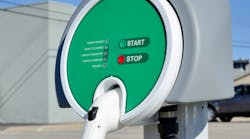Customers and transportation professionals are aligning on a prediction that will reshape the energy industry and the entire planet: Electric vehicles will eventually become the dominant mode of personal transportation in our country. This will of course require OEMs to make cars, and customers to buy them. For our part, energy providers will play a critical role in the transition — ensuring those cars are charged.
EVs made up roughly 2% of all vehicles on the road in the U.S. auto market in 2021, according to a report from IHS Markit. The same report predicts the share will grow beyond 10% by 2023, which is significant growth by anyone’s standard.
The Biden administration set a goal that EVs will comprise 40 to 50% of all new vehicle sales by 2030, and to add 500,000 public EV charging stations by that same year. Auto industry executives expect EV adoption to grow from around 2 million electric vehicles currently to 22 million vehicles by 2030.
For the energy sector, our role is to provide, improve upon and create accessibility to a complete and thorough EV charging infrastructure. There are myths related to EV charging that persist and must be overcome to enable adoption.
Let’s dispel some of these EV charging infrastructure myths. In doing so, we’ll highlight how the energy sector will play a key role:
First, “range anxiety” — running out of power or being unable to find a charging station — is still one of the most significant fears of driving an EV.
The fact is average American drivers travel about 30 miles per day. The typical Level 2 home charger can add 20 to 30 miles of range per hour, so most drivers on most days will not require public charging. For the times public charging is required, there are chargers available today, with more coming online each week.
Second, there’s a common misconception revolving around the energy grid itself – the worry that increased demand for energy as more EVs are being driven will tax our nation’s electric grid. What often gets overlooked is that the nation’s grid is built for the peak load points and has excess capacity many other times of the day. In Michigan, our customers’ energy use falls by half most nights, meaning we have excess capacity that’s available to serve EV drivers who will largely charge overnight. In fact, the first customers in our Consumers Energy EV programs in Michigan are doing 85 to 90% of their charging overnight at home.
That said, all the extra capacity won’t help if the local poles and wires distributing energy to neighborhoods and homes are not ready. This is a real challenge, but one that we have time to solve as we learn and grow with the EV market. Last, the idea that our use of “dirty” energy is more harmful than the benefits of reduced emissions brought on by EV adoption is another misconception that we can refute. The electric industry is not the country’s largest source of greenhouse gas emissions. As of 2015, the transportation sector accounts for nearly 25% of global emissions and is the single-largest greenhouse gas emitter in the U.S. Our industry emissions are actually 40% below 2005 levels, and continuing to decrease. For our part, Consumers Energy is closing all our coal plants by 2025. Other energy providers are also replacing coal and natural gas with greener sources of energy such as wind and solar.
The path forward is emerging because the transportation sector is changing before our eyes.
While some will only see the effects of the transition in the form of new vehicle offerings, the energy industry is busy laying the groundwork for this monumental shift.
We’re seeing trends in Michigan that may serve as a blueprint for other energy providers and customers. For instance, Consumers Energy set a goal of powering over 1 million EVs by the end of the decade and has laid groundwork by providing rebates for over 1,600 EV chargers at homes, businesses and public places through the PowerMIDrive program. This program is geared toward helping Michigan businesses switch to electric vehicles by providing planning resources, expert guidance and further financial incentives.
Additionally, we’ve already installed 36 fast charging stations across Michigan; by 2024, we plan on powering an additional 200 new EV charging stations across the state — including 100 more fast chargers. Most EV owners who currently charge at home and work will soon see more widely available public EV charging stations, whose mere presence will address the range anxiety of later adopters. Further, increasing the number of EV charging stations provides equitable access to EV ownership and will extend opportunity for those who rent or live in multi-family housing, apartments, or other city dwellings. The EV transformation in Michigan and across the U.S. is picking up speed. While automakers will put new all-electric models on the showroom floor, energy providers will play an equally important role. We’ll need to keep taking steps today to power our nation’s vehicles for generations to come.
Sarah Nielsen is the executive director at Consumers Energy for Electric Vehicle Programs.


